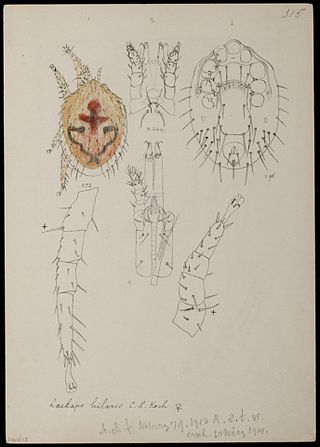
Mites are small arachnids. Mites span two large orders of arachnids, the Acariformes and the Parasitiformes, which were historically grouped together in the subclass Acari. However, most recent genetic analyses do not recover the two as each other's closest relative within Arachnida, rendering the group non-monophyletic. Most mites are tiny, less than 1 mm (0.04 in) in length, and have a simple, unsegmented body plan. The small size of most species makes them easily overlooked; some species live in water, many live in soil as decomposers, others live on plants, sometimes creating galls, while others are predators or parasites. This last type includes the commercially destructive Varroa parasite of honey bees, as well as scabies mites of humans. Most species are harmless to humans, but a few are associated with allergies or may transmit diseases.

The house mouse is a small mammal of the order Rodentia, characteristically having a pointed snout, large rounded ears, and a long and almost hairless tail. It is one of the most abundant species of the genus Mus. Although a wild animal, the house mouse has benefited significantly from associating with human habitation to the point that truly wild populations are significantly less common than the semi-tame populations near human activity.

Mange is a type of skin disease caused by parasitic mites. Because various species of mites also infect plants, birds and reptiles, the term "mange", or colloquially "the mange", suggesting poor condition of the skin and fur due to the infection, is sometimes reserved for pathological mite-infestation of nonhuman mammals. Thus, mange includes mite-associated skin disease in domestic mammals, in livestock, and in wild mammals. Severe mange caused by mites has been observed in wild bears. Since mites belong to the arachnid subclass Acari, another term for mite infestation is acariasis.

Demodicosis, also called Demodex folliculitis in humans and demodectic mange or red mange in animals, is caused by a sensitivity to and overpopulation of Demodex spp. as the host's immune system is unable to keep the mites under control.

Trombicula alfreddugesi, also called Eutrombicula alfreddugesi, is a species in the genus Trombicula.

The black myotis is a vesper bat species from South and Central America.
The Cypriot mouse is a species of mouse endemic to Cyprus. Its primary habitat seems to be the vineyards and fields of the Troödos Mountains region.
The Ethiopian striped mouse or striped-back mouse is a species of rodent in the family Muridae. It is only found in Ethiopia. It was formerly classified in the monotypic genus Muriculus, but phylogenetic evidence supports Muriculus being a subgenus within Mus, the true mice. The Ethiopian striped mouse's natural habitats are subtropical or tropical high-altitude grassland and urban areas. It is threatened by habitat loss.
Mus mayori is a species of rodent in the genus Mus, the mice. Its common names include Mayor's mouse, highland rat, and spiny mouse. It is endemic to Sri Lanka.
The earth-colored mouse is a species of rodent in the family Muridae. It is found in India, possibly Indonesia, Nepal, and Pakistan. The earth-colored mouse lives in cultivated fields in raised moist mounds of Earth, where they burrow and locate their nest about 20 cm or 8 inches deep. Living in a raised mound of soil offers them more oxygen flow from air coming through the surrounding sides as well as from above. In contrast, their co-existing sibling species Mus booduga burrow in the flat parts of the field, which allows for niche differentiation.
The Yemeni mouse is a species of rodent in the family Muridae. It is found in Saudi Arabia and Yemen. It is the only modern member of the tribe Praomyini to be found outside of Africa.

The St Kilda field mouse is a subspecies of the wood mouse that is endemic to the Scottish archipelago of St Kilda, the island 40 miles (64 km) west of Benbecula in the Outer Hebrides, and 100 miles (160 km) from mainland Scotland. Unique to the islands, the mouse is believed to have arrived on the boats of Viking settlers more than a millennium ago. It is not to be confused with the St Kilda house mouse, a subspecies of the house mouse which is now extinct.

Dermanyssoidea is a superfamily of mites, including most of the mites which parasitise vertebrates.

Listrophorus is a genus of parasitic mites in the family Listrophoridae. North American species with their hosts include:

Laelaps is a genus of common parasitic mites in the family Laelapidae. Species, with their hosts, include:
Demodex injai is a hair follicle mite in the domestic dog.
Demodex conicus is a hair follicle mite found in the ear canal of the house mouse, Mus musculus.
Soricidex is a genus of tiny mites that live on the head and body of its host species, the common shrew. Only one species has been formally described, Soricidex dimorphus, but V. Bukva mentions two more undescribed species from his collection. S. dimorphus exhibits dexual dimorphism, a feature unseen in its family, Demodecidae.
Demodex zalophi is a species of mite within the family Demodecidae. The species is the first demodicid to be described from marine mammals, first being documented from California sea lions in 1979. Occurrences of the species have also been recovered in captive sea lions in California, Texas, and Australia. It is known to inhabit other species of pinnipeds such as northern fur seals and is assossiated with causing hyperkeratosis, alopecia and puritis, with topical amitraz showing to be an effective treatment.










